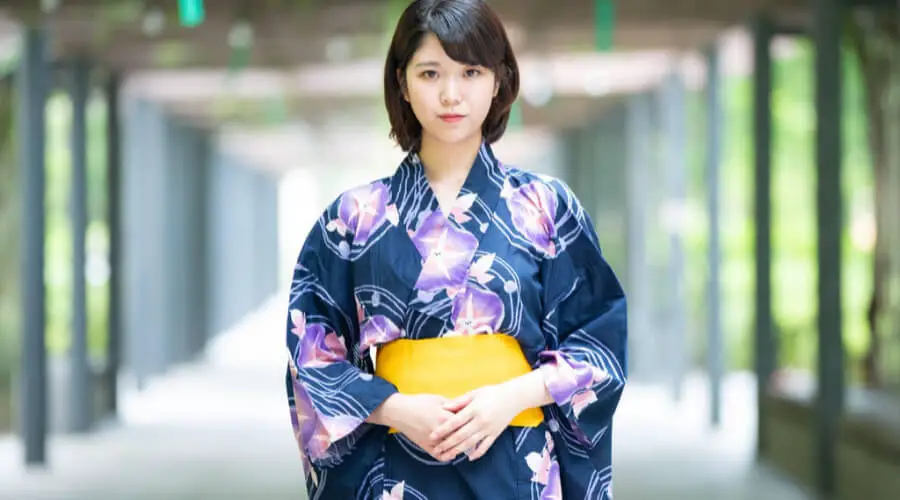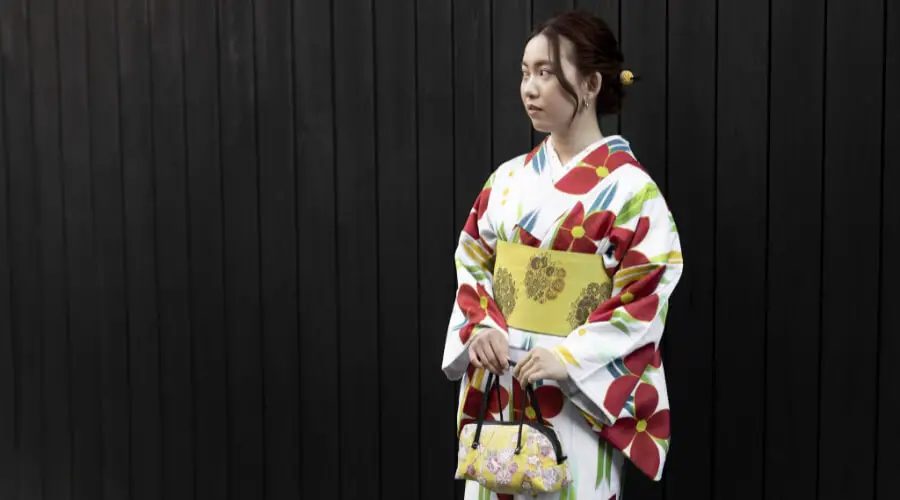Both Kimono and Yukata are traditional Japanese garments, but the kimono is formal, with intricate designs, worn for special occasions. Yukata is casual, with simpler patterns, often donned in summer or at festivals.
Comparison Between A Kimono And A Yukata
| Aspect | Kimono | Yukata |
|---|---|---|
| Occasions | Formal events, ceremonies, weddings | Informal, summer, festivals |
| Fabric | Silk or other high-quality materials | Lightweight cotton |
| Patterns | Elaborate, intricate designs | Simple, casual patterns |
| Layers | Multiple layers, often with undergarments | Single layer |
| Obi (Sash) | Wide and elaborate obi | Narrow, simple obi or belt |
| Accessorizing | Numerous accessories like kanzashi, obijime, obidome | Fewer accessories |
| Footwear | Geta or zori sandals | Geta sandals or casual footwear |
| Seasons | Appropriate year-round | Primarily worn in the summer |
| Tying Technique | Complex and requires assistance | Easier to put on and tie |
| Cost | Expensive due to materials and craftsmanship | More affordable |
What Are A Kimono And A Yukata?

The kimono was initially introduced as a Japanese version of traditional Chinese clothing referred to as the hanfu. Kimono dresses are essentially T-shaped garments made of four different pieces. The pieces are joined with elaborate folds and held together at the waist using the obi belt. The kimono is a very popular garment in Japan, and despite having numerous layers, this formal occasion clothing is irrefutably practical. On the other hand, a yukata is a type of aesthetic garment kimono designed for a lighter fabric and is more suitable for daily use.
Sometimes a yukata is referred to as a “yukata kimono” because it almost looks like a kimono and is made of light materials with more versatility and a more suitable style for a much more casual setting. A yukata is often made of a breathable fabric such as cotton and lightweight synthetic materials to ensure the wearer is comfortable during summer.
A yukata takes its name from the Japanese word for a bathing robe, which is how this piece of clothing initially came to be. This is why from a fashion perspective, yukatas bridge the gap between a summer dress, bathrobe, and kimono.
What Are The Differences Between A Kimono And A Yukata?

It is quite easy to recognize the kimono and the yukata when you come across one as they are different garments. However, many people don’t understand the differences between these two. Below are the noticeable differences between these two traditional Japanese clothing.
Season
One of the main differences between the two garments is the season each is worn. Yukatas are typically associated with summer seasons and festivals. Yukatas are also worn in and around Onsen villages in summer but hardly during winter. This is because yukatas are made of cotton, linen, or hemp. These materials are super light and have breathable layers for the summer heat or humidity.
Kimonos have more layers than yukatas and can be worn at any time of the year. You can also accessorize a kimono with additional accessories during winter to keep warm. For instance, you may wrap a fur shawl when it’s cold, which acts as an accessory. During summer or hot seasons, you can wear a summer kimono, also known as the hitoe. The hitoe is single-layered and unlined clothing that keeps you cool when it’s hot.
Material
A kimono garment is commonly made of different variations, including silk, but a yukata garment is made of cotton linen or hemp. The silk material gives a kimono a more luxurious look and feel, whereas the yukata typically has a more casual and relaxed look.
Nonetheless, nowadays, the kimono and yukata are found in various variations of silk and cotton. Therefore, it will depend on the look you want to go for.
Collar
Kimonos are more formal than yukata, and therefore they have a soft, full-width collar. On the other hand, yukatas only have stiff half-width collars. The collars are indicative of the fabrics the garments are made of.
Additionally, kimonos have at least two collars, one being close to the neck while the other is below the neck, also known as a Cuban collar.
Sleeves
Another major difference between a kimono and a yukata is the shape and length of the garments’ sleeves. When designing a kimono, many things are considered to determine the length of the sleeves, for instance, the wearer’s age and the event’s formality.
However, one example is that unmarried women wear wide sleeves reaching down to the floor.
A yukata, however, has modest sleeves that don’t go over 50cm of length. Therefore, the sleeves of a yukata do not touch the ground.
Event and Occasion
Kimonos and yukatas are worn at different events and occasions. You will be able to determine whether it’s a kimono or a yukata depending on the occasion where you spot the garment. A kimono is reserved for formal events, including shrine ceremonies, weddings, anniversaries, Coming of Age celebrations, or graduation ceremonies.
Yukatas are worn during summer, especially in or around Ryokan and Onsen villages. The Japanese people wear the yukatas when attending summer matsuri or firework celebrations. They are also perfect for casual strolls.
Obi
Although a kimono and a yukata deserve an obi, how the garment is tied, and its size will help you determine whether the obi is part of a kimono or a yukata. If you are wearing a kimono, you will require at least three or four strings for tying up the clothing. A kimono’s obi may also get a little thick towards the middle of the clothing. Kimono obis are also stiff and flat.
If you wear a yukata, you will only need one or two strings to tie the robe. The yukata obi is not as stiff and wide as a kimono. You will also tie a yukata obi in a more relaxed manner than you would when tying a kimono.
Many people are developing a new style of bows; therefore, you may notice some alterations with the obi. For instance, it may be twisted or folded a little at the front, guaranteeing that the garment is a part of a yukata, as this doesn’t typically happen with kimonos.
Design and Color
Kimonos are usually worn on formal occasions. Therefore, they may have grandeur designs and luxurious subtleties. Yukatas are more casual, and therefore people have been experimenting with bright and bold colors to come up with new designs. Yukatas also allow for unusual patterns and various accessories that you cannot wear with a kimono.
Shoes
The other difference between a kimono and a yukata is the type of footwear to wear with both. Yukatas are usually worn alongside Geta (wooden sandals), whereas kimonos are usually worn with Zori (thick sandals) or Tabi (Japanese socks divided at the toes).
Affordability
Silk is a more expensive material than cotton and other fabrics used to make a yukata. Therefore, a kimono will be more expensive than a yukata. The kimono’s designs will also reflect the cost of the fabric.
Although the kimonos and yukatas are complex, they have become very popular recently. These two Japanese clothing offers plenty of styles and variety. The two types of clothing have succeeded in modernization, especially through the design of accessories they can be dressed with, including the obi.
Wearing a kimono for the first time can be hard if you are not familiar with how to wear it properly. On the other hand, Yukatas are very easy to wear and versatile.
How often do Japanese people wear kimonos?
Japanese people don’t wear kimonos on a daily basis in modern times. Kimonos are primarily reserved for special occasions such as weddings, tea ceremonies, traditional festivals, and formal events. They are considered traditional and formal attire, so their regular use has significantly declined in favor of Western clothing for everyday wear. However, you can still see people wearing kimono during cultural celebrations and certain ceremonies, preserving this important aspect of Japanese heritage.
Why did the Japanese stop wearing Kimonos?
The decline in regular kimono-wearing in Japan can be attributed to several factors:
- Westernization: During the Meiji Restoration (late 19th century), Japan underwent a period of rapid modernization and Westernization. Western clothing styles, such as suits and dresses, became popular and more practical for daily life.
- Industrialization: As Japan industrialized, people needed more practical and comfortable clothing for factory work and other modern occupations, which kimono didn’t provide.
- Cost and Complexity: Kimonos are expensive and require specialized dressing skills. Maintaining a kimono wardrobe became impractical for many as Western clothing offered convenience and affordability.
- Cultural Shifts: Changes in lifestyle and social norms led to a shift away from traditional attire. The kimono became associated with formal occasions rather than everyday wear.
- Gender Roles: Kimonos had specific gender roles and rules for wear. Western clothing allowed more gender-neutral and practical options.
- Climate: Japan’s climate also played a role. Kimonos are not well-suited for Japan’s hot and humid summers.
References:
https://shop.japanobjects.com/blogs/editorial/yukata-kimono
https://www.bokksu.com/blogs/news/yukata-vs-kimono

